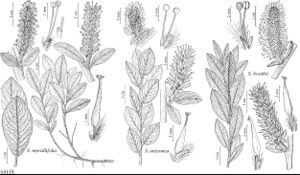Salix myrtillifolia
Öfvers. Kongl. Vetensk.-Akad. Förh. 15: 132. 1858.
Plants 0.1–0.6 (–1) m, (forming clones by layering). Stems (decumbent); branches gray-brown, redbrown, or yellowbrown, not to strongly glaucous (dull or slightly glossy), pubescent; branchlets gray-brown, redbrown, or yellowbrown, sparsely pubescent. Leaves: stipules rudimentary, foliaceous, or absent on early ones, foliaceous on late ones (0.2–1.8 (–5) mm); petiole deeply to shallowly grooved adaxially, 1.5–8 mm, glabrous or pubescent adaxially; largest medial blade (sometimes amphistomatous), elliptic, narrowly elliptic, obovate, or broadly obovate, 17–74 × 8–30 mm, 1.2–4.5 times as long as wide, base cuneate, convex, or subcordate, margins flat, serrulate, crenulate, or sinuate, apex acute, convex, or acuminate, abaxial surface not glaucous, glabrous, adaxial slightly glossy, glabrous; proximal blade margins crenate; juvenile blade reddish or yellowish green, glabrous. Catkins flowering as leaves emerge; staminate stout, 11.5–39 × 5–14 mm, flowering branchlet 0.5–6 mm; pistillate moderately densely flowered or densely flowered, slender or stout, 16–46 (–50 in fruit) × 4–15 mm, flowering branchlet 1.5–12 mm; floral bract brown, black, tawny, or bicolor, 0.4–1.1 mm, apex retuse or acute, abaxially hairy throughout or proximally, hairs curly or wavy. Staminate flowers: adaxial nectary oblong, ovate, or square, 0.2–0.34–0.4 mm; filaments distinct, glabrous; anthers purple turning yellow, 0.3–0.6 mm. Pistillate flowers: adaxial nectary square, oblong, or ovate, 0.2–0.4 mm, shorter than stipe; stipe 0.6–1.7 mm; ovary pyriform, glabrous, beak gradually tapering to or slightly bulged below styles; ovules (6–) 10–14 per ovary; styles connate or distinct 1/2 their lengths, 0.3–0.7 mm; stigmas flat, abaxially non-papillate with rounded tip, or 2 plump lobes, 0.16–0.23–0.32 mm. Capsules 4–6 mm. 2n = 38.
Phenology: Flowering early May-late Jul.
Habitat: Treed bogs, fens, stream banks, subalpine spruce thickets, Pinus contorta woods, sand dunes, coal spoils
Elevation: 90-2800 m
Distribution

Alta., B.C., Man., N.B., N.W.T., Nunavut, Ont., Sask., Yukon, Alaska, Colo., Wyo.
Discussion
Salix myrtillifolia occurs in Nunavut on Akimiski Island in James Bay.
The complex of species related to Salix myrtillifolia includes S. arizonica, S. ballii, S. boothii, and S. pseudomyrsinites. Two are diploid (S. arizonica and S. myrtillifolia), and two are tetraploid (S. boothii and S. pseudomyrsinites); the chromosome number of S. ballii is unknown. They have been treated taxonomically in different ways, but are relatively distinct in their morphology, ecology, and geography. Salix myrtillifolia has outlying populations represented by single collections each from Colorado, Quebec, and Wyoming. Specimens attributed to this species from the Gaspe Peninsula, Quebec, and the Northern Peninsula, Newfoundland, all have evidence of leaf glaucescence and are S. ballii. See 57. S. pseudomyrsinites and 58. S. ballii for more description.
Hybrids:
Salix myrtillifolia forms natural hybrids with S. candida.
Selected References
None.
Lower Taxa
"-0.32mm" is not declared as a valid unit of measurement for this property.
